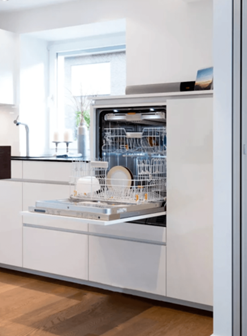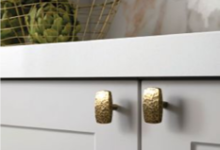
The Wellness Kitchen 2023
The wellness kitchen was a trending topic in kitchen design before COVID-19 hit. At the start of 2023, however, the wellness trend has gained momentum. As a result of the pandemic, people are thinking more than ever: how can I make my kitchen a healthy place for me and my family?
In his editorial in the June/July 2022 issue of Kitchen and Bath Design News, Eliot Sefrin reports that kitchen and bath design pros are currently dealing with demographic changes, technological innovations and product trends that have emerged due to the impact of COVID.
A recent report by the American Society of Interior Designers revealed that health and wellness has become a top priority of homebuyers and remodeling clients. People want simpler, cleaner, easier-to-maintain kitchens. Further, they want products that promote a sense of well-being and provide an escape from modern-day stress. ASID predicts that wellness features and “healthy design” will soon become nearly universal in new and remodeled homes.
Kitchen designers have reported that they are including wellness features in their designs because they know design choices affect homeowners’ well-being. Plus, people are asking for them. .
What is a Wellness Kitchen?
The pandemic and a desire for one’s home to be a safe and healthy space has generated an increased interest in ways to make a remodeled kitchen become a “wellness” kitchen. The kitchen should be flexible, efficient and adaptable for multitasking. Plus, it needs to function well and contribute to everyone’s safety. And look good too!
Sanitation has become an important consideration in kitchen and bath design, with a growing emphasis on anti-bacterial surfaces, indoor air quality (IAQ), non-porous materials, mold-resistant drywall and insulation and no/low volatile organic chemical paints and finishes.
It’s no longer enough for kitchens to look nice, homeowners want their kitchens to help them feel good too.
Where Did Wellness Design Come From?
Before COVID, the “green” movement of the early 2000s focused on avoiding toxic chemicals in the home and creating a healthy environment for people. Cabinet manufacturers got onboard by reducing or eliminating VOCs in their products, from plywood to finishing materials. (See #7 in the following list.)
What Homeowners Consider Important for Their Wellness Kitchen
The Research Institute for Cooking and Kitchen Intelligence (RICKI) surveyed more than 1000 homeowners in 2022. They asked what health and wellness elements are most important to them as they considered a kitchen remodel.
The results show that homeowners, no matter the generation they belong to (Gen Z, Millennials, Gen X and Boomers), consider water quality most important for their wellness kitchens. Following in importance is lighting quality (see #9) below, air quality (see #8 below), air circulation and acoustics.
What Goes Into a Wellness Kitchen
Kitchen designers are incorporating some or all of the following 14 items in their wellness kitchen designs.

1. Kitchen Garden

Growing your own food encourages healthy eating, adds oxygen to the air and reduces your dependence on grocery stores. Not to mention, gardening provides a sense of accomplishment, no matter how large or small your garden is. In addition, you can eliminate buying small amounts of herbs in plastic boxes (which are not recyclable) when you grow herbs on the windowsill.
Thanks to an increased focus on wellness, more options for indoor gardens are available than ever before. You can easily grow an indoor garden with LED lights and timers. The internet is filled with resources, such as Epicgardening.com that has an entire section devoted to indoor gardening for beginners.
2. Compost

Composting has many benefits, from reducing landfill waste to keeping the soil in your home garden healthy. Thus, it’s an ideal part of the wellness kitchen. Composting in today’s wellness kitchen isn’t the same as your Grandma’s with that smelly bucket under the sink. Now you can get compost bins that hide food waste without adding smell or fruit flies to your kitchen. Whirlpool’s Zera Food Recycler turns food scraps into compost in a mere 24 hours.
Manufacturers of cabinet storage accessories have included composting and recycling in their line of waste products.
3. Social Space

Having the space to socialize is an important part of wellness kitchen design. Enjoying the company of family and friends in your kitchen contributes to overall health and well-being. A large island is the perfect centerpiece of the social kitchen, with room for food prep, room for standing and moving around and room to sit and converse.
4. Biophilia
Our well-being as human beings is fundamentally linked to nature and beauty. Being in nature or even simply seeing scenes of nature increases pleasant feelings and reduces anger and stress. Nature and beauty make us feel better emotionally. Additionally, they contribute to our overall wellness. They reduce blood pressure, heart rate and muscle tension and increase stress-relieving hormones.

Biophilia is defined as the human instinct to connect with nature and other living beings. The term comes from the Greek words for “life” and “love or affection.” Thus, its literal translation is “love of life.”
In kitchen design, biophilia is the term for incorporating nature and natural materials into the room design. It’s definitely part of the wellness kitchen.
The wellness kitchen brings the outdoors inside to provide that all-important connection to nature. Plant walls, green growing plants, skylights and large windows do the job and do it well.
However, bringing nature in doesn’t have to be just about house plants. Materials found in nature, such as wood and stone, have a place in the wellness kitchen.

5. Universal Design | Ergonomics
According to the World Health Organization, more than one billion people or about 15% of the global population live with some type of disability. For the ultimate wellness kitchen, homeowners’ ages, heights and abilities should be considered during the kitchen design planning process.
Here are a few suggestions:
- Non-skid floors
- Dishwasher height raised so the top and bottom racks are at a comfortable height
- Different seating heights at the island to accommodate all family members
- Deep drawers organized so that contents can be accessed easily and moved efficiently


6. Storage Space

De-cluttering is therapeutic. Our eyes and brain are soothed when surfaces are clutter-free. A sense of order and being able to find things reduces stress.
A wellness kitchen design should include lots of in-cabinet storage to get clutter off countertops and into cabinets. An appliance garage and in-drawer storage are solutions for corner cabinets.
7. Non-toxic Materials
Experts recommend using cabinetry, paint and other materials with few or no volatile organic compounds (VOCs) or other noxious chemicals in a wellness kitchen. Reputable manufacturers freely disclose the levels of VOCs in their products. Your kitchen designer can discuss with you how to best accomplish reducing VOC limits for interior paints, adhesives, sealants, insulation and flooring.
8. Good Ventilation
The wellness kitchen must incorporate air purification products that provide clean indoor air quality. Your designer will probably recommend a radon detector to warn about unsafe levels of radon, a major lung cancer risk. Further, a carbon monoxide detector for each floor and working smoke alarms are essential.
9. Lots of Natural and LED Lights

Adding windows and skylights and possibly enlarging existing windows will bring in natural light. Lots of natural light in your wellness kitchen has proven health benefits, which are:
- boosted physical, emotional and psychological wellbeing
- increased productivity
- conserved energy
- helping indoor gardens thrive
To supplement the natural light in a wellness kitchen, use LEDs. LED lighting is long lasting and energy friendly. Beyond that, LED lights can minimize seasonal affective disorder (SAD), which is definitely not healthy.
10. Appliances
Today’s appliances, such as steam ovens, sous vide and air fryers, offer healthier food prep options than those available in the past. In addition, dishwashers have high temperature sanitizing cycles.
11. Bacteria-Fighting Surfaces
The wellness kitchen must have surfaces that are easily disinfected. Products with antibacterial glazes can help reduce the amount of harmful bacteria in a kitchen. There are even paints that kill bacteria.
12. Color

Color has a huge influence on a person’s mood, and the way colors are used in design has become a part of the wellness kitchen. Certain colors and patterns effect our brains, so using nature-inspired colors promotes calm and wellness.
13. Minimal Waste
In a wellness kitchen, food storage, preparation, cooking and disposal are all about fresh food and organic ingredients. Food from the grocery store comes wrapped in paper and plastic that adds to landfills. Kitchens designed for wellness would include storage for foods that minimize waste.

In a wellness kitchen, fresh produce from local farms and home-grown produce has no packaging that goes into landfills.
Most refrigerators, cabinets and pantries are designed to store pre-packaged foods. But fresh ingredients need to be stored so that freshness and nutritional value are maintained.
14. Touch-free Elements


People who are remodeling want, as much as possible, to have a “touch-free” kitchen. After all, the chance of infection is lowered if no one touches anything. They want items like motion-sensor faucets and lighting controls; no-touch hardware for cabinets and vanities and smart-home technology that reduces the need to touch countertops and other surfaces.
Conclusion
Wellness design is here to stay. Further, the future of kitchen design is in creating spaces that support our health and wellness. The pandemic has caused people to want a kitchen that isn’t just functional and good looking, but one that allows them to follow a healthy lifestyle.
People are spending 90% of their time indoors or in vehicles, environments that are not conducive to good health. We crave the positive influences of nature, beauty and fine design.
Sources
KBB Nov/Dec 2022 “Designing For Wellbeing”
Kitchen & Bath Design News June/July 2022
Jamie Gold, in her book Wellness By Design
Residential Products Online – Sanitizing and Antimicrobial Products
Forbes.com. Residential Design Forecast
Residential Products Online. What You Should Know About Wellness Design.
Wellness Kitchen Design Trends
Lancaster Online.com. Building a Wellness Kitchen
KDP exists to offer insight and advice about all things related to kitchen remodeling. Our goal is to connect homeowners with talented, experienced kitchen designers who live and work in their communities. We are a serious resource for anyone preparing to remodel their kitchen so they can make the best possible choices about designers, contractors and products.



